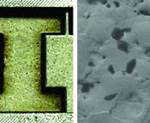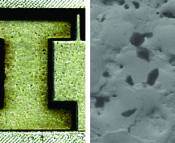Beating Business Volatility in Automotive Tooling
Constant-velocity cutting offers low-cost, high-tech option to hand finishing EDM electrodes.
In tooling for injection molded plastic components, little things mean a lot. For moldmakers, these little things require the slowest metal-removal process, which is EDM. At Michael Tool & Mold (Windsor) Ltd. in Canada, machining blocks of graphite into EDM electrodes was one of the mold build stages they wanted to improve.
To do that, Michael Tool retrofitted two key production machines with new constant velocity cutting (CVC) controls. Developed by Miceli Technologies, CVC is a quantum leap over conventional numerical controls for machine tools. Both companies are based near Windsor. Michael Tool in Oldcastle, ON and Miceli Technologies in Essex.
Michael Tool makes tooling for highly visible automotive interior and exterior components such as consoles, instrument-panel components and door panels known as “trim”. The company also makes tooling for under-the-hood components, such as air cleaners and automotive lighting.
All of these molded parts have sections that are too complex and intricate to be machined. Visible outer surfaces are highly stylized or textured and too elaborate to be machined. Nonvisible inner surfaces have closely spaced gussets, ribs, mounting bosses and clip towers for fasteners with many inside corner radiuses too tight to be machined.
These surfaces and details must be “burned” into the steel with EDM. Three, four and even five sets of electrodes may be required. The shop’s owners—John Sulaiman and Andy Hui—have found that their Miceli CVC retrofits have considerably reduced most of the tedious and costly hand finishing that was such a big part of electrode production.
Sulaiman and Hui also find the CVC productivity gains help offset unprecedented volatility in orders and ever-tighter delivery schedules. “It is common for customers to change their minds, starting jobs and stopping them,” says Sulaiman. “We have been compelled to change not only our way of thinking, but also the way we manufacture.”
Michael Tool & Mold’s response to this volatility has been to boost flexibility to respond to sudden change. Because machining EDM electrodes is crucial to most molds, a big portion of the gain is due to the two Miceli CVC retrofits. They went onto a pair of Fadal 4020 VMCs in 2008 and early this year.
The 30-year-old, family-owned company designs and builds tooling, generates prototypes and offers short-run production. It has six computer-controlled machine tools in an 18,400-square-foot plant.
Graphite Gains at a Glance
Benefits in electrode machining attributable to the Michael Tool & Mold retrofits of constant velocity controllers (CVCs) from Miceli Technologies include:
- Three-fold increase in finish machining
- Five-fold increase in rough-machining
- Seven-fold tightening in tolerances for programming, to 0.0001 inch
- Elimination of semi-finish machining
- On-the-fly toolpath offset updates—a big need amid volatility
Both Fadals were originally equipped with relatively simple, stock numerical controls. Those controls had tiny buffer memory—where machine tool programs are stored as they run approximately 250 lines. That was enough for only the shortest, simplest and least precise programs. Almost any job at Michael Tool required far more lines of code than the controller could handle.
That limitation meant that the original controls were constantly reloading code while the machine tools ran short of data during cutting. Sulaiman explains that this buffer overload meant data starvation at the machine tool. Machine operators were forced to reduce the programmed feedrate, wait for the machine to catch up and then reset the feedrate back to its original setting. The result was an endless cycle of slowing down and speeding up.
These inconsistent feedrates dealt sizeable blows to machining productivity and cutting tool life. An option was to run at a non-optimal feedrate the controller could handle, but issues of cycle time and surface finish arose.
With the MTI controllers, Sulaiman says, “We have read in up to 750,000 lines of code with no information processing problems. This is where we get the constant feedrates. This is one of the great advantages of the MTI controllers, their ability to read in vast amounts of data, almost limitlessly and at high speed.” (MTI controllers can read in about 3 million lines of code.)
The MTI retrofits were easy decisions. The alternatives were:
- Continuing to use an older controller and being left at competitive disadvantages in quality and on-time delivery.
- Remaining at a cost disadvantage because of hand finishing.
- Buying new or late-model used machines plus new tooling, post-processors, communications and training; that was unaffordable.
Moreover, getting a new or used machine tool fully into production takes several weeks. The retrofits were done in Michael Tool’s shop in fewer than three weeks each. “Relative to the amount of work they did, downtime was minimal,” Sulaiman says. “We would have lost a lot more time if we had bought a new machining center.”
In electrodes, Michael Tool’s gains from the CVC retrofit are dramatic—the ability to program to as little as 0.0001-inch instead of 0.0007. “That is a drastic tightening in programming tolerances,” he notes. “It eliminated hand finishing on some electrodes completely and reduced the remainder by 50 percent. Constant cutting velocity, even around corners,” Sulaiman adds, “gives us smooth machine tool movement. In electrodes that is critical in finishes.”
CVC has also taken electrode machining from a three-stage process to just roughing and finishing; semi-finish machining was eliminated. In turn that has helped hike overall shop productivity and boosted on-time delivery performance.
Michael Tool is also getting much better cutting tool life. “Our diamond-coated cutters and end mills now last up to six times longer than the coated-carbide cutters we were using,” Sulaiman explains. “The longer life is due to the greater wear resistance of the diamond coating and the constant feedrates the MTI controllers provide us.”
In addition, excessive stress on the Fadals that comes with the abrupt acceleration and deceleration of conventional machining is avoided. “Less stress on the machine means less wear and tear,” Sulaiman points out, “and that ultimately equates to less downtime” due to repairs.
“The time we save in machining graphite electrodes has proven to be pivotal in remaining competitive and reducing leadtimes,” he concludes, “doing it right the first time helps us stay competitive.”
Related Content
Industry Report: Automotive Outlook, Forecast, Disruptions and Industry Transitions
A recent presentation by Auto Forecast Solutions shares some interesting trends to help those who work within the automotive industry better understand key trends.
Read MoreU.S. Economy Indicates Prospects for Moldmakers
An examination of the U.S. economy suggests its resilience against a recession, yet a mixed outlook for moldmaking and plastics persists.
Read MoreMold Innovations Power Unique Auto Lighting Elements on Hummer EVs
Diamond machining, electroforming of micro-optical inserts and modified latch-lock system help injection molds produce unique forward lighting elements.
Read MoreHarbour Results, AutoForecast Solutions Release Battery-Electric Vehicle Market Study
The study analyzes the transition from an industry dominated by the internal combustion engine to battery-electric mobility and its impact on the supply chain, which will have ripple effects from automakers to tool and die shops.
Read MoreRead Next
Electrode Effect on a Quality EDM Finish
The production of fine surface finishes in the cavity does not come with the technological improvements of the EDM sinker unless an electrode material of higher quality is used.
Read MoreHow to Use Continuing Education to Remain Competitive in Moldmaking
Continued training helps moldmakers make tooling decisions and properly use the latest cutting tool to efficiently machine high-quality molds.
Read MoreAre You a Moldmaker Considering 3D Printing? Consider the 3D Printing Workshop at NPE2024
Presentations will cover 3D printing for mold tooling, material innovation, product development, bridge production and full-scale, high-volume additive manufacturing.
Read More





















